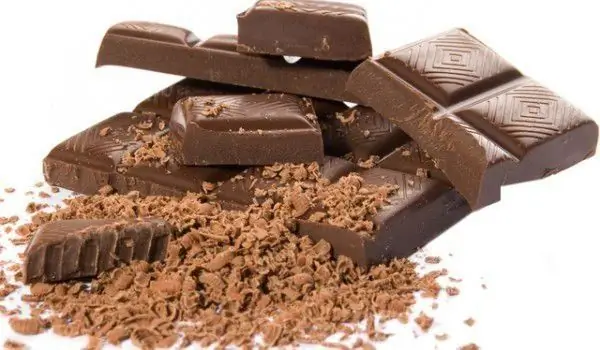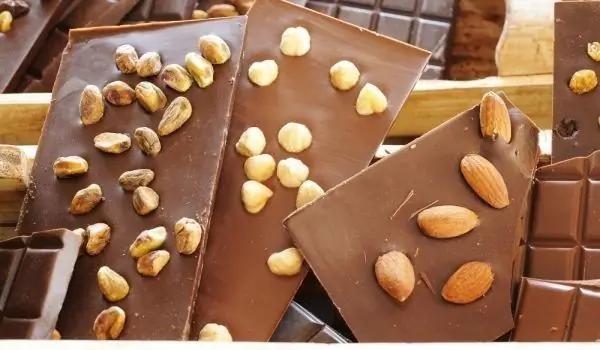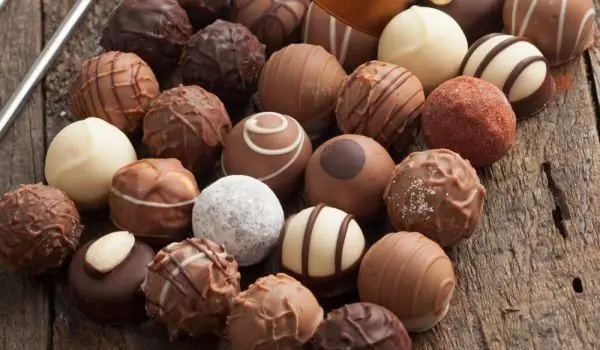2025 Author: Jasmine Walkman | [email protected]. Last modified: 2025-01-23 10:18
The chocolate is a delicious end product obtained from fermented, roasted and ground cocoa beans. The main ingredients of chocolate are cocoa mass (the dry part of cocoa beans) and cocoa butter (fat in the seeds). Natural chocolate is made from these two ingredients by adding a sweetener, most often sugar. Milk (milk chocolate), different types of nuts (hazelnuts, almonds), raisins and other fruit fillings can also be added to the chocolate. White chocolate is made only from cocoa butter, without adding cocoa mass. Aerated chocolate containing a certain amount of air in the form of bubbles.
Types of chocolate
- Natural (dark) chocolate - with a higher content of cocoa mass, darker color and slightly bitter taste;
- Milk chocolate - with the addition of milk powder;
- Fine milk chocolate - with the addition of butter and milk powder;
- White chocolate- of cocoa butter, milk and sugar and does not contain chocolate liqueur and theobromine, which gives it a white color.
According to the method of production, the chocolate is filled with Pralinov, Waffle, Dense, Aeroshocolate, with Chocolate figures. As a rule, chocolate should be bitter, with a maximum cocoa content (over 60%). Today, however, chocolates are deliberately produced too sweet, and natural oils are being replaced by artificial flavors. They allow the taste to be sweeter and more tempting. In response, chocolate masters in Switzerland founded an association to fight for "pure" chocolate. The cocoa from which chocolate is made is a complex mixture of over a hundred flavor components.

To reach today's hundreds of types of chocolate and chocolate products on the market, the contribution of the Maya and Aztecs must be noted. The name "chocolate" itself comes from the word "chocolatl." In Aztec, the word is Nahuatl ("xococ" - bitter and "atl" - water or drink)., worthy only of the highest people in their countries. The chocolate is coming from Central America because the tropical cocoa tree only grew there.
After its discovery, it was transferred to other tropical countries, and from there gradually to different parts of the world. For many centuries, only a hot beverage was produced from cocoa. The Indians themselves, who were the first to use cocoa beans in food, collected them from the ground and mixed them with hot water, adding chili. According to archeological research, centuries ago even chocolate beer was produced in Central America.
According to psychiatrists, the desire to eat chocolate is nothing more than a subconscious attempt to increase phenylethylamine levels to feel the joy of life again. That is why chocolate is increasingly juicy as an excellent remedy for depression and as a good helper against a number of diseases. Chocolate does not spoil the form if it is consumed in the purest form and in moderation and if the chocolates do not contain milk, sugar, nuts, raisins. Dark chocolate is the most dietary and is the basis of the human health benefits of the sweet temptation.
Composition of chocolate
100 g of natural chocolate contains 517 kcal, white chocolate contains 522 kcal, and milk chocolate - 545 kcal.

Usually dark chocolate contains 61% carbohydrates, 30% fat and 5-8% protein. The fats in it are composed of saturated fatty acids - stearic (34%) and palmitic (27%), monounsaturated - oleic (34%) and only 2% polyunsaturated, represented by linoleic acid. Chocolate is also an excellent source of many minerals, including potassium, magnesium, copper and iron.
A healthy dose of chocolate should contain 260 or less milligrams of polyphenols. The chocolate aroma, which is rich in volatile substances, is easily recognizable because of the wine, fruit and color nuances that our nose easily captures. Chocolate also contains biologically active substances such as caffeine (found in both coffee and black tea) and flavonoids (in tea and red wine). Flavonoids have antioxidant, vasodilating and improve endothelial function in the vessel wall.
Mandatory components in the composition of chocolate are 4, which must be listed on the package: cocoa butter, cocoa mass, powdered sugar and lecithin (emulsifier, which is an additive to cocoa butter and is produced from soybean or sunflower oil).
Cocoa butter is the most expensive component in the composition of chocolate, so often some manufacturers replace it partially or completely with other low-quality fats. It is important to know that none of these oils can replace 100% cocoa butter in taste and physicochemical properties. According to the established quality standards for chocolate, the content of filling in it may not be less than 20% for chocolate weighing more than 50 g, and not less than 35% for chocolate weighing less than 50 g.
Today, chocolate contains various emulsifiers, and the most common is lecithin E322. It is produced by processing soybean oil, which in turn can be naturally or genetically modified. Information on genetically modified products contained in chocolate is only required when their share is more than 5%. The lecithin in chocolate is about 0, 3-0, 4%, so manufacturers are not required to indicate whether it is natural or not. The presence of hydrogenated fats in the chocolate content is a sign of its low quality.

Suitability and storage of chocolate
In Rule the shelf life of the chocolate is 6 months for chocolates without filling and 3 months for chocolates with filling. There are also chocolates with a shelf life of 12-18 months. If the chocolate has only cocoa butter and does not contain other fats, it can be stored for 2 years. This is due to the natural antioxidants contained in cocoa butter, which prevent fats from oxidizing. It has been proven that chocolate should be stored at a temperature below 17 degrees, because in the heat it grows useless microorganisms. It is best to keep the treats in the refrigerator to keep its shape intact and not to melt.
Chocolate in cooking
Chocolate is the most used product in confectionery. It is very widely used - used in a number of cakes and chocolate cakes, chocolate muffins, chocolate cakes, chocolate rolls and thousands of sweet temptations. It combines perfectly with cream, strawberries, milk and many other products needed in the confectionery industry, making it versatile and most commonly used. Chocolate is used as a filling in world-famous croissants, it is used in hundreds of chocolate creams and chocolate pastes.
Benefits of chocolate
Chocolate contains natural antioxidants - catechins that slow down the aging process in the body. It has a source of flavonoids and phenols, prevent heart attacks and strokes. They protect and strengthen the circulatory system, prevent narrowing of blood vessels. A block of about 10-20 g per day is able to expel bad cholesterol from the body and regulate cholesterol levels in general. In addition, regular consumption of dark chocolate can reduce the likelihood of stroke by between 22 and 46%.
Chocolate is absorbed quite fast from the human body, so it is a fast source of energy for each of us. The substance flavanol, which is contained in cocoa beans, improves thought and makes it faster, experts say. Chocolate contains phenylethylamine, which is synthesized by our brain. This substance stimulates the functioning of the body and quickly improves mood. It is also synthesized when a person is in love and has the ability to speed up the heart rate, increase energy levels and create a romantic mood.
The substance tryptophan, which is contained in chocolate, contributes to the production of endorphins - the hormones of happiness. It is even believed that chocolate can cure depression. It has already been proven that chocolate does not spoil teeth, it even contains substances that protect tooth enamel. Chocolate cures cough even better than special drugs.

Chocolate helps in toxicosis during pregnancy. In addition, it reduces the risk of complications during and after childbirth because it relaxes muscles and strengthens blood vessels. Chocolate is also used as a strong beautifier. Although it was once thought that it could cause pimples on the face or rashes, scientists today have defeated this claim. Today, cocoa and chocolate extract is a component of many products in the cosmetics industry, and chocolate itself is used for therapies for face, hair, etc.
Due to its rich content of magnesium, phosphorus and calcium, which regulate cellular metabolism, chocolate has been proven to strengthen the bone system. Chocolate is a powerful aphrodisiac. Chocolate is the king of natural aphrodisiacs and contains anandamine and phenylethylamine. The cocoa contained in chocolate contains tryptophan, which is important for serotonin, which in turn helps to relax.
Doctors of medieval Europe assured their patients that chocolate calms the liver, helps digestion, relieves heart pain. Chocolate is eaten in the treatment of tuberculosis, anemia, gout, to reduce fever.
Harm from chocolate
All the benefits of natural chocolate evaporate if it is consumed in excessive amounts. It has been proven that eating more cocoa pleasure can cause a migraine attack, especially in women. According to some scientists, chocolate can act on the brain like marijuana. This is due to anandamide, which is contained in cocoa. This substance excites neurons in the brain that are sensitive to the cannabinoids of marijuana (cannabis). However, anandamide is a rather small component of chocolate and you need to eat a total of 40 kg of chocolate to feel the intoxication caused by smoking marijuana.
According to other studies, people who often consume chocolate, are more prone to nervous disorders. An American study shows that chocolate maniacs are more prone to depression. Often, the cocoa temptation can cause depression and is not a cure for it, because people who regularly consume chocolate and chocolate products are more likely to become depressed and melancholy. There are several reasons for this, but the main one is rooted in the stress that is increases appetite for chocolate. However, eating jam has only short-term benefits and can be a bad joke in the long run.
Other experts believe that children who eat a lot of candy and chocolate every day are significantly more prone to adult violence than those who are not so attached to chocolate. According to another study, when a person eats chocolate, it means that he is in dire need of magnesium. An alternative to sweets in this case are foods such as walnuts, seeds and legumes.

Chocolate diet
There is even a chocolate diet. It includes 100 grams of bitter chocolate a day with a cup of dark coffee, which speeds up metabolism, plus water or tea. The diet promises a loss of 4 pounds per week. According to statistics, people spend up to $ 7 billion a year on chocolate, and chocolate consumption has been shown to increase significantly in late fall. The average annual consumption of chocolate by one person is 5.5 kg. Chocolate has been produced in France since 1615, and to this day an exhibition of chocolate is held there annually in October.
Recommended:
Today Is National Chocolate Cake Day

Today you can solemnly enjoy a chocolate dessert since January 27 is noted National Chocolate Cake Day . The favorite chocolate cake has undergone great development over the years. And while eating the chocolate cake that everyone likes, you can learn some interesting facts about it.
They Created Chocolate That Doesn't Melt In The Heat

Belgian scientist Frederic Dipere has created chocolate that has the property of not melting in the heat. The idea did not come to his native Belgium, known for frequent rains and not so warm temperatures, but to distant Shanghai, where he was at a scientific conference five years ago.
Ideas For Delicious Chocolate Drinks

Chocolate drinks can be quite high in calories, but they become so delicious that it is quite difficult to resist. It is true that we are on the verge of summer and now is the time when most people try to get in shape, but a chocolate drink will not hurt so seriously.
There Is A Difference Between The Chocolate We Eat And The Chocolate In Germany

An experiment by bTV shows that there is a significant difference between chocolates of the same brand sold in Bulgaria and Germany. It was reported by food experts. Two chocolates with whole hazelnuts were brought to the studio. At first glance, it became clear which chocolate is sold in Germany and which in our country.
Chocolate Dresses And Treats Parade For The Chocolate Salon In Paris

For the annual Chocolate Salon, the French capital will in the coming days welcome fans of the favorite sweet temptation with 20,000 square meters covered with chocolate. This year's event will present the latest trends in the production of chocolate treats, and as part of the high fashion of chocolate you can see chocolate dresses and chocolate houses.

